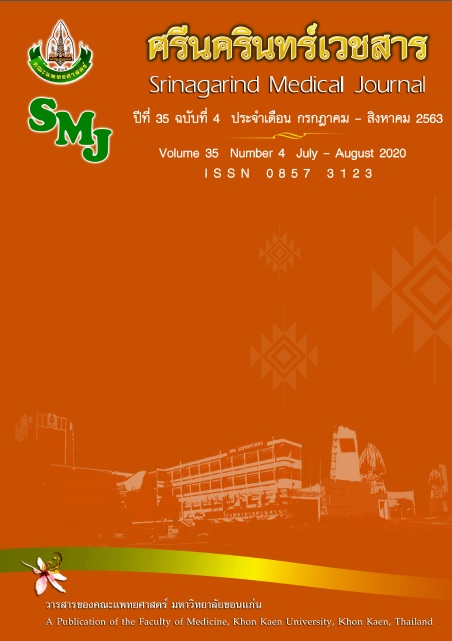Indications of Neurovascular Diseases and Trend, in Srinagarind Hospital: Angiographic Base
Abstract
ข้อบ่งชี้และแนวโน้มของโรคหลอดเลือดสมองและไขสันหลังที่ได้รับการตรวจด้วยการฉีดสีในโรงพยาบาลศรีนครินทร์
วิทวัฒน์ ทะกอง, ธีรวัชร ฤกษ์สุนทรี, กิตติภพ สมบูรณ์นิธิผล, วรานนท์ มั่นคง
ภาควิชารังสีวิทยา, กลุ่มวิจัยรังสีวินิจฉัยและหัตถการทางหลอดเลือดสมอง คณะแพทยศาสตร์ มหาวิทยาลัยขอนแก่น
หลักการและวัตถุประสงค์: เพื่อศึกษาข้อบ่งชี้และแนวโน้มของโรคหลอดเลือดสมองและไขสันหลังที่ต้องได้รับการฉีดสีหลอดเลือดในโรงพยาบาลศรีนครินทร์
วิธีการศึกษา: การศึกษาย้อนหลังข้อมูลผู้ป่วยที่ได้รับการฉีดสีหลอดเลือดสมองและไขสันหลังครั้งแรกในช่วงปี พ.ศ. 2557-2559 โดยศึกษาอายุ เพศ ข้อบ่งชี้ในการฉีดสีหลอดเลือด และผลการวินิจฉัยจากภาพฉีดสีหลอดเลือด รวมทั้งแสดงแนวโน้มภายในสามปี
ผลการศึกษา: ผู้ป่วยจำนวน 739 ราย ที่ได้รับการตรวจด้วยการฉีดสีหลอดเลือดสมองและไขสันหลังด้วยวิธีมาตรฐานในช่วงปี พ.ศ. 2557-2559 มีอายุเฉลี่ย 46.33 ปี ข้อบ่งชี้ที่พบมากที่สุด คือ ผู้ป่วยที่มาด้วยภาวะเลือดออกใต้เยื่อหุ้มสมองชั้นกลาง ร้อยละ36.54 ข้อบ่งชี้ลำดับถัดมา คือ ตาโปนแดง ร้อยละ 13.40 กลุ่มโรคทางหลอดเลือดสมองที่ได้รับการวินิจฉัยมากที่สุด 5 อันดับแรก ได้แก่ หลอดเลือดสมองโป่งพอง ร้อยละ 37.61 หลอดเลือดสมองสร้างผิดปกติ ร้อยละ17.59 ไม่พบรอยโรคหลอดเลือดสมอง ร้อยละ 11.31 หลอดเลือดสมองบาดเจ็บจากอุบัติเหตุ ร้อยละ 11.23 และ รูรั่วหลอดเลือดสมองบริเวณเยื่อหุ้มสมอง ร้อยละ 7.98 ส่วน 4 กลุ่มโรคที่พบน้อย ได้แก่ หลอดเลือดบริเวณศีรษะและลำคอสร้างผิดปกติ ร้อยละ 7.58 หลอดเลือดสมองตีบอุดตัน ร้อยละ 3.92 โรคหลอดเลือดหรือเนื้องอกไขสันหลัง ร้อยละ1.62 และโรคหลอดเลือดสมองเด็ก ร้อยละ 0.14
สรุป: ข้อบ่งชี้และแนวโน้มของโรคหลอดเลือดสมองในภูมิภาคตะวันออกเฉียงเหนือมีความหลากหลายทั้งอาการแสดงและกลุ่มโรค ในสถาบันของเรามีแนวโน้มของโรคหลอดเลือดและไขสันหลังสูงขึ้นตามการพัฒนาของทีมผู้ให้การรักษาและคุณภาพของระบบส่งต่อผู้ป่วย
คำสำคัญ: การฉีดสีหลอดเลือดสมอง; การฉีดสีหลอดเลือด; ไขสันหลัง; โรคหลอดเลือดสมอง
Background and Objective: To evaluate frequency of indication of the neurovascular diseases and trends in Srinagarind hospital, the northeastern of Thailand by angiographic based
Material and Methods: This is a descriptive retrospective study of patients who was underwent first diagnostic cerebral or spinal angiography, listed in the database of intervention neuroradiology unit between 2014-2016. We interested in age, sex, indication for diagnostic cerebral and spinal angiography and disease diagnosis classified by angiographic based. We described the trends of diseases in 3 years.
Results: 739 patients were performed diagnostic angiography between 2014-1016 with mean age of 46.33 years. The most frequent indication for diagnostic angiography is subarachnoid hemorrhage (36.54%), followed by eye symptoms (13.40%). Five most common diagnosis by angiographic based are intracranial aneurysm (37.61%), intracranial neurovascular malformations (17.59%), negative diagnostic angiogram (11.31%), traumatic neurovascular disease (11.23%) and intracranial DAVFs (7.98%). Four uncommon diseases are head/neck tumor and vascular malformations (7.58%), ischemic and steno-occlusive disease (3.92%), spinal vascular disease and spine/spinal cord tumor (1.62%) and pediatric neurovascular disease (0.14%), respectively.
Conclusion: Overall indication and trends neurovascular disease in northeastern of Thailand is variable among clinical presentation and disease classification. In our institute, trends of the common and uncommon diseases seem to be increased, related to development capacity of our multidisciplinary teams and quality of regional referral systems.
Key words: Cerebral Angiogram; Spinal angiogram; Neurovascular disease
Introduction
Despite of development in non-invasive imaging, cerebral angiography (CA) remains the gold standard in evaluating and treating cerebrovascular diseases.1-3 Several advances in endovascular technology and techniques have been brought the field of endovascular treatment of extracranial and intracranial cerebrovascular diseases to the forefront.4 As in the Northeastern of Thailand, CA was performed in many years, from conventional CA, 2D-diagnostic cerebral angiography to 3D-diagnostic angiography. In the era of 3D-diagnostic angiography with advanced endovascular therapy, interventional neuroradiology has evolved with increasing numbers of 3D-anngiography.
As a referral center of Northeast of Thailand, our institute plays role as the center of neurovascular disease. Kitkhuandee et al. had described cerebral angiographic finding of non-traumatic subarachnoid hemorrhage (SAH) in Northeastern patients in the era of 2D-diagnostic angiography.5 The small aneurysm detection rate increased from 57.6% to 75.6% after 3D-diagnostic angiography
Nowadays, there is only SAH study was described in our region but the other neurovascular diseases had not been studied yet. In this study, we sought to elucidate current frequency of indication for diagnostic angiogram and trends of the neurovascular diseases in the northeastern of Thailand by angiographic based.


